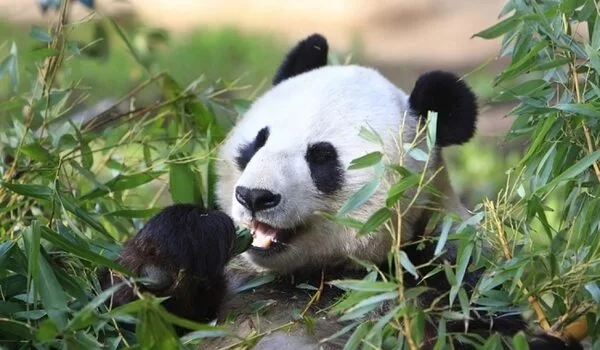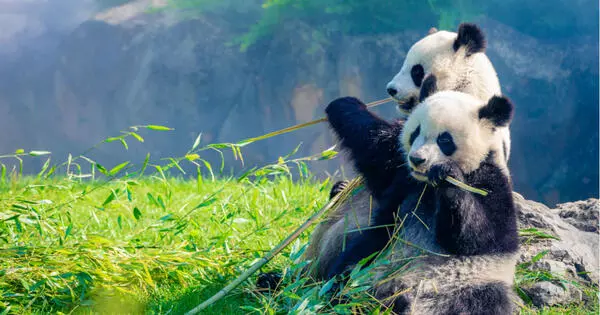An ancient fossil reveals the earliest panda to survive solely on bamboo, as well as the evolution of panda false thumbs. A new study of panda poop has finally provided an answer to an age-old question: How do giant pandas survive on a diet of 99 percent bamboo when they have carnivore guts? Plant-eating animals have longer intestines to aid in the digestion of fibrous material, which black-and-white bears do not have.
When is a thumb no longer a thumb? When a giant panda’s elongated wrist bone is used to grasp bamboo. The panda’s hand has never developed a truly opposable thumb, instead evolving a thumb-like digit from a wrist bone, the radial sesamoid, over its long evolutionary history. Despite being bears, this unique adaptation allows these bears to subsist entirely on bamboo (members of the order Carnivora, or meat-eaters).
In a new paper published in Scientific Reports, the Natural History Museum of Los Angeles County’s Curator of Vertebrate Paleontology Xiaoming Wang and colleagues report on the discovery of the earliest bamboo-eating ancestral panda to have this “thumb.” Surprisingly, it’s longer than its modern descendants.
Deep in the bamboo forest, giant pandas traded an omnivorous diet of meat and berries to quietly consuming bamboos, a plant plentiful in the subtropical forest but of low nutrient value. Tightly holding bamboo stems in order to crush them into bite sizes is perhaps the most crucial adaptation to consuming a prodigious quantity of bamboo.
Dr. Xiaoming Wang
While the celebrated false thumb in living giant pandas (Ailuropoda melanoleuca) has been known for more than a century, the evolution of this wrist bone was unknown due to a near-complete lack of fossil records. A fossil false thumb from an ancestral giant panda, Ailurarctos, discovered at the Shuitangba site in Zhaotong, Yunnan Province in south China and dating back 6-7 million years ago, provides scientists with a first look at the early use of this extra (sixth) digit—and the earliest evidence of a bamboo diet in ancestral pandas—helping us better understand the evolution of this unique structure.
“Deep in the bamboo forest, giant pandas traded an omnivorous diet of meat and berries to quietly consuming bamboos, a plant plentiful in the subtropical forest but of low nutrient value,” says NHM Vertebrate Paleontology Curator Dr. Xiaoming Wang. “Tightly holding bamboo stems in order to crush them into bite sizes is perhaps the most crucial adaptation to consuming a prodigious quantity of bamboo.”

How to Walk and Chew Bamboo at the Same Time
Because bamboo has very little nutritional value, pandas must consume 12-38kg of it every day to meet their energy requirements. They do, however, branch out, with other plants and even meat accounting for about 1% of their diet. While pandas are mostly vegetarian, they will occasionally hunt for pikas and other small rodents. Indeed, giant pandas, as members of the bear family, have the digestive system of a carnivore, despite the fact that they have evolved to rely almost entirely on bamboo. Because of their reliance on bamboo, they are vulnerable to habitat loss, which is currently the most serious threat to their survival.
This discovery could also help to solve a long-standing panda mystery: why are their false thumbs so underdeveloped? As an ancestor of modern pandas, Ailurarctos might be expected to have even less developed false “thumbs,” but the fossil Wang and his colleagues discovered revealed a longer false thumb with a straighter end than its modern descendants’ shorter, hooked digit. So, why did pandas’ false thumbs stop growing in order to achieve a longer digit?
“The panda’s false thumb must walk and ‘chew,'” says Wang. “Such a dual function limits the size of this ‘thumb.'”
Wang and his colleagues believe that the shorter false thumbs of modern pandas are an evolutionary compromise between the need to manipulate bamboo and the need to walk. A modern panda’s hooked second thumb allows them to manipulate bamboo while carrying their impressive weight to the next bamboo meal. After all, the “thumb” serves as the radial sesamoid, a bone in the animal’s wrist.
“Five to six million years should be enough time for the panda to develop longer false thumbs, but it seems that the evolutionary pressure of needing to travel and bear its weight kept the ‘thumb’ short-strong enough to be useful without being big enough to get in the way,” says Denise Su, associate professor at the School of Human Evolution and Social Change and research scientist at the Institute of Human Origins at Arizona State University, and co-leader of the project that recovered the panda specimens.
“From a carnivorous ancestor to a pure bamboo-feeder, pandas must overcome many obstacles,” Wang explains. “The most amazing development against these obstacles may be an opposable ‘thumb’ from a wrist bone.”





